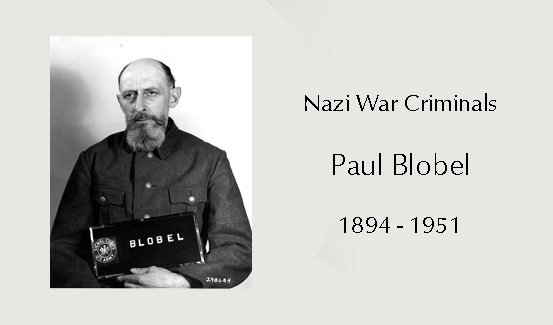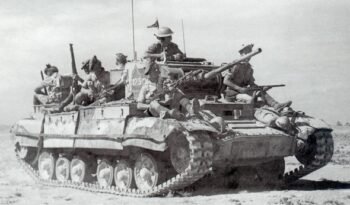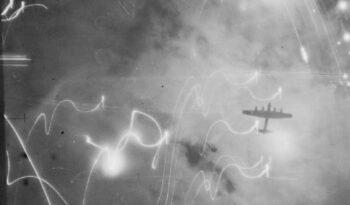Nazi War Criminals – Paul Blobel
Paul Blobel, a high-ranking SS officer in Nazi Germany, played a significant role in the implementation of the Holocaust and other war crimes during World War II. As one of the commanding officers responsible for the mass shootings and extermination operations, Blobel’s name became synonymous with the heinous acts committed by the Nazi regime.
Early Life and SS Career: Born on August 13, 1894, in Potsdam, Germany, Paul Blobel began his career in the military during World War I, serving in the artillery. During his military service he was awarded the Iron Cross (first class) and been promoted. Following the war however he was unemployed until 1919. Between 1919 and 1929, he studied and then worked as an architect before he lost his job in Great Depression. Like many Germans who were personally impacted by the global economic crisis, Blobel joined the Nazi Party (NSDAP) and then the Schutzstaffel (SS) after which he was recruited to the SD whilst employed as a police officer in Dusseldorf. He later became SD chief in Salzburg.
Due to his position in the SD, Blobel was sent to the town of Pretzch in the summer of 1941 to prepare for a ‘special action’ to be completed when the Germans invaded the Soviet Union.
Along with other members of the SD, the Waffen SS and the Ordnunspolizei, Blobel was to be part of a unit to move behind the army and kill enemies of the German state, such as Communists, party officials and Jews. These units were grouped into four ‘Eisatzgruppen’, which consisted of units of men referred to as ‘Sonderkommnados’ and ‘Einsatzkommandos’. The Einsatzgruppen each numbered between 900 and 500 men each and each was well equipped with small arms such as rifles and submachine guns as well as a very high quota of motorised transport to make them highly mobile.
Blobel was appointed the commander of Sonderkommando 4a, which was part of Einsatzgruppen C.
This unit was active in the Reichkommissariat Ukraine, after the area was captured by the Wehrmacht during Operation Barbarossa.
Role in the Holocaust: Blobel’s notorious role in the Holocaust came during Operation Reinhard, the Nazi plan to exterminate Jews in occupied Poland and in the Soviet Union. As head of Sonderkommando 4a, a special unit tasked with carrying out mass shootings, Blobel orchestrated the systematic murder of tens of thousands of Jews.
Amongst other actions, he created a Nazi ghetto for Jews in Zhytomyr in August 1941, enclosing 3,000 people who were murdered a month later.
Blobel, to begin with, incited local inhabitants in the newly occupied areas to engage in pogroms against Jews. For example, in August 1941 in Zhytomyr he initially arranged hangings of Jews with signs suggesting this was in reprisal for killing Germans. One such event was staged on 7th August in which a Jewish judge, Wolf Kieper, and his assistant were to be hung in front of a large gathering. A Wehrmacht truck driver witnessed the scene, where he described Jewish men who had been assembled under SS guard:
’round and about stood about 150 civilians watching. There were also, of course, members of the Wehrmacht among the onlookers. The Jews sat on the ground…. The guards asked the people standing around if they had any scores to settle . Thereupon more and more Ukrainians spoke up and accused one or other of the Jews of some misdemeanour. These Jews were then beaten and kicked and ill-treated where they were, mostly by Ukrainians. This went on for about forty five minutes. Then [two] from the group were taken out and executed on the gallows’.
After this hanging Blobel turned to his subordinate and told him “now four hundred Jews are going to be shot”. The victims were led to a pit outside town and gunned them down in batches.
Blobel attempted to justify his actions, when later on trial, by stating that he had been informed that Himmler (Reichfuhrer-SS) had ordered ‘all suspected Jews to be shot’ in response to a Soviet order that all SS members and Nazi party member were to shot. Blobel, who falsely claimed to have been ‘horrified and raised objections’, also stated he had been ordered that ‘women and children were to be shot also in order not to have any revengers remain’.
On 17th September 1941, Blobel left Zhytomyr and two days later arrived in Kyiv which had fallen to the Germans earlier. The Soviets had heavily mined the city and Blobel found it served his purpose to blame this on the Jews in his reports to Berlin. Blobel was present when Major General Kurt Eberhard (military commander of the city) and SS and Police leader Friedrich Jeckeln decided that all the Jews in the city would be killed as retaliation for a large explosion in the city. Blobel’s unit (Einsatzgruppe 4a) would be a key part of the force that perpetrate the murders.
On 28th September Blobel directed his Ukrainian militia to post notices that all Jews were to assemble the following day and to bring with them ‘documents, money, valuables, as well as warm clothes, underwear etc’. The notice stated that any Jew who did not assemble and was found elsewhere would be shot. Blobel reported that ‘at the same time it was passed around by word of mouth that all the Jews in Kiev were to be resettled’. What was to follow is now known as the Babi Yar massacre.
The assembled victims were marched towards the murder site, a massive ravine, and passed through a series of funnel like choke points where they were split into groups of thirty or forty. All the while being hurried, screamed at, beaten and relieved of any possessions as they got closer. A witness, a truck driver named Hofer, described how tis happened:
‘I watched what happened when the Jews—men, women and children—arrived. The Ukrainians led them past a number of different places where one after the other they had to give up their luggage, then their coats, shoes and over-garments and also underwear. They also had to leave their valuables in a designated place. There was a special pile for each article of clothing. It all happened very quickly and anyone who hesitated was kicked or pushed by the Ukrainians to keep them moving’.
Once they victims arrived at the site any remaining clothes were forcible stripped from them and there was a barrage of violence with clubs and knuckle dusters, dogs snarling and aggression – all deliberately organised to ensure maximum fear and disorientation. The Germans had cut access channels to the ravine, the bottom of which was about the size of a two lane road – this was the killing site. Hofer describes what happened next in his testimony:
‘Once undressed, the Jews were led into [Babi Yar]… when they reached the bottom they were seized by members of the Schutzpolizei and made to lie down on top of Jews that had already been shot. This all happened very quickly. The corpses were literally in layers. A police marksman came along and shot each Jew in the neck with submachine gun at the spot where he was lying. When the Jews reached the ravine they were so shocked by the horrifying scene that they completely lost their will’
33,771 Jews were shot and killed in a ravine over two days. Executions would continue at the site every Tuesday and Friday for a year.
Later in 1941, Blobel was to receive the first gas vans in which victim were crammed and then gassed by the vehicle fumes. The victims killed in these ‘Sonderwagen’ suffered a terrifying death which could take as much as twenty minutes. When the victims were removed from the vans they had often mutilated each other in horrific ways in their desperate agony and were so entwined in death that their limbs had to be severed to separate the bodies from each other so they could be put into the mass graves.
Blobel was relieved of his command on 13th January 1942 due to alcoholism. He had previously had a mental breakdown in 1941 due to his role organising and directing the killings in the USSR. Blobel was consigned to a hospital where he was visited by Reinhard Heydrich and where he may have developed the concept of gas chambers for the extermination camps in Poland.
In June 1942, Blobel was given a new task – destroying any evidence of the Nazi mass killings in Eastern Europe. This became known as ‘Aktion 1005’ and lead him to organise the exhumation of mass graves and the disposal of the human remains, such as by fire, in an effort to ensure that no evidence remained.
Later in the war, Blobel was to be in charge of an anti-partisan group operating in Yugoslavia.
Trial and Conviction: With the end of World War II, Blobel was captured by Allied forces and held accountable for his crimes. He was indicted and subsequently stood trial at the Nuremberg Military Tribunals as part of the Einsatzgruppen Case. In 1948, Blobel, who had pleased ‘not guilty’ arguing that he was only following orders, was found guilty of war crimes and crimes against humanity, specifically for his role in organizing mass shootings. He was sentenced to death by hanging and executed on June 7, 1951.
Blobel showed no remorse during his trail or after and declared ‘I have adhered to my loyalty and my discipline as a soldier. That discipline and loyalty have brought me to the gallows now. Even today, I still do not know how I should have acted differently’.
Legacy and Lessons: Paul Blobel’s role in the Holocaust serves as a stark reminder of the depths to which human beings can sink when fueled by hate, ideology, and blind loyalty. His actions and those of others involved in Nazi atrocities stand as a testament to the immense suffering inflicted upon millions of innocent people.
The Holocaust remains one of history’s darkest chapters and most important lesson, a tragic reminder of the consequences of unchecked hatred and discrimination.


READ MORE.
– The White Rose Movement (Article about German student resistance movement)
LINKS.
– World War II Collection (World War II themed merch from High Speed History)




